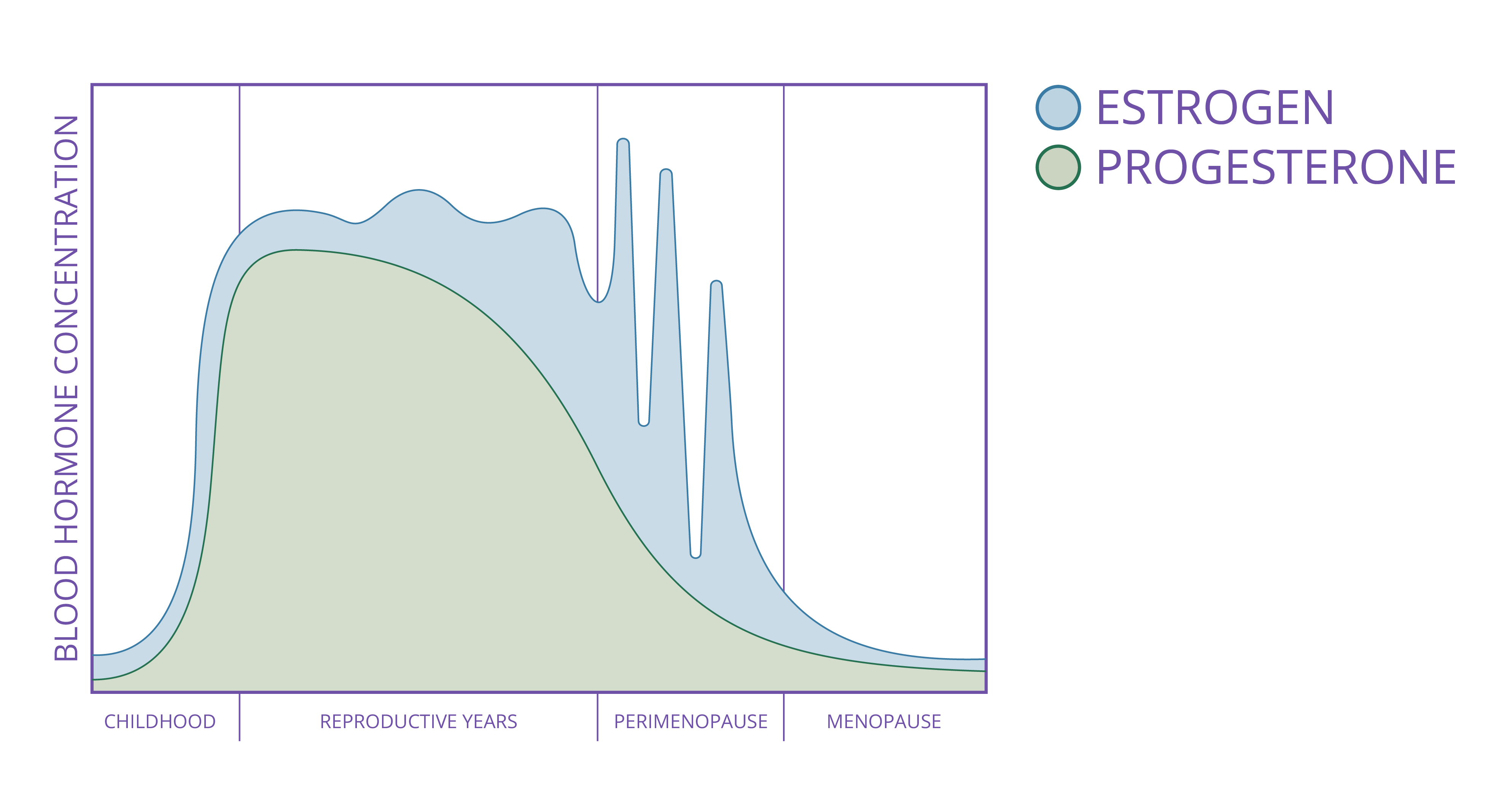Written by Lauren Lund, APRN-CNP
Reviewed by Laurianne Scott, DO, OBGYN
Last Updated on 10/13/2025
You have been doing some research and keep reading about progesterone, progestins, and micronized progesterone. What does all of this mean? Are you experiencing symptoms due to progesterone problems? In this article, we will explain everything you need to know about progesterone.
What is Progesterone?
Progesterone is a naturally occurring hormone produced mainly by a woman’s ovaries after ovulation (during the luteal phase), and in smaller amounts by the adrenal glands and, during pregnancy, the placenta. It plays a vital role in regulating the menstrual cycle, supporting fertility, and maintaining overall hormone balance.
Low progesterone can be caused by many different factors. According to The Cleveland Clinic, the following are the most common causes of low progesterone:
- Perimenopause: The time just before menopause when your hormone levels decline.
- Anovulation: When Ovulation doesn’t occur (your ovary doesn’t release an egg)
- Polycystic ovary syndrome (PCOS): A hormone imbalance that causes missed periods (anovulation) and unpredictable ovulation.
- High Cortisol: Cortisol is your stress hormone, and too much of it can interfere with your body’s ability to make progesterone. Mental stress and physical stress (extreme dieting and exercise) can cause high cholesterol.
- Hypothyroidism: A slow or under-active thyroid makes it harder for your body to make progesterone.
- Hyperprolactinemia: Your body makes too much prolactin, the hormone responsible for lactation. Prolactin disrupts other sex hormones like progesterone, leading to irregular cycles or loss of your menstrual period.
- Low cholesterol: Very Low levels of cholesterol can cause low progesterone because cholesterol is used as a building block of many hormones.
Testing for Low Progesterone
Your provider can order lab testing to check your progesterone level. Progesterone levels fluctuate throughout the your menstrual cycle. If you have a regular monthly cycle (~28 days), it is important to check your progesterone on Day 19-22 of your cycle which is when your progesterone will likely peak.
.webp)
*This graph from Dutch Test shows the hormone fluctuations of a cycling/menstruating female. Day 1 = first day of period. Day 14 = Ovulation which is when an egg is released.
Changes with Menopause
Like other reproductive hormones, progesterone levels decrease as you age and enter the menopause transition. This drop in progesterone during perimenopause can lead to symptoms such as mood swings, anxiety, sleep disturbances, and irregular periods.

*This graph from Dutch Test shows the decline in progesterone in perimenopause and menopause. It also shows the fluctuations of estrogen during perimenopause and then the decline of estrogen in menopause.
What is Micronized Progesterone?
Micronized progesterone is a bioidentical form of the hormone progesterone, meaning it has the same molecular structure as the progesterone naturally produced by a woman’s body. It’s commonly prescribed in capsule or topical cream form and plays an important role in balancing hormones—especially during perimenopause, menopause, or in women using estrogen therapy.
Progesterone .vs. Progestins
You may have also heard of progestins. Progestins and micronized progesterone are not the same. Synthetic progestins (like medroxyprogesterone acetate) are man-made hormones that act similarly to progesterone but are not identical to the body’s natural hormone. Micronized progesterone, on the other hand, is bioidentical and comes from plant sources. Micronized progesterone tends to have fewer side effects, with a more natural effect on mood, sleep, and metabolism.
Who Is a Candidate for Micronized Progesterone treatment?
Micronized progesterone may be recommended for women who:
- Are perimenopausal or postmenopausal and using estrogen replacement therapy (to protect the uterus from estrogen’s effects).
- Experience irregular cycles, PMS, or heavy menstrual bleeding caused by hormonal imbalance.
- Have sleep disturbances, anxiety, or mood changes that tend to worsen in the second half of their cycle (Day 16-28 = Luteal Phase).
- Have been diagnosed with low progesterone on lab testing or through clinical symptoms.
Benefits of Progesterone
Many women experience noticeable improvements in how they feel once progesterone levels are supported. Benefits can include:
- Better sleep quality
- Improved mood and reduced anxiety
- Cycle regulation – supports more predictable menstrual cycles.
- Endometrial protection – prevents uterine lining buildup (endometrial hyperplasia) in women using estrogen therapy.
- Reduced perimenopausal symptoms such as breast tenderness, bloating, and irritability.
How to Use Micronized Progesterone
- Micronized Progesterone is available at retail pharmacies with a prescription. If you do not have insurance, you can use GoodRx.
- The dose depends on your individual hormone levels, menstrual status, and whether you’re taking estrogen therapy.
- Your provider may recommend taking micronized progesterone on certain ays of your cycle or every day.
- Taking your medication at the same time each day helps maintain stable hormone levels. It is often recommended to take your progesterone at night due to it's benefit of improved in sleep quality.
- Always follow your provider’s instructions and never adjust your dose without medical guidance.
Possible Side Effects of Micronized Progesterone
Micronized progesterone is generally well tolerated, but side effects can occur, especially when starting or changing the dose. These may include:
- Drowsiness or fatigue (Recommended to take at night before bed)
- Mild dizziness
- Breast tenderness or bloating
- Mood changes or irritability
- Spotting between periods (especially early on)
If side effects persist, your provider can adjust the dose or timing to help minimize them.
FAQs on Progesterone
I had my uterus removed (a hysterectomy). Do I still need to take progesterone?
If you’ve had a hysterectomy, you generally don’t need progesterone solely for endometrial protection. However, some women still use micronized progesterone for its sleep and mood benefits. Your provider can help determine if it’s right for you.
How soon will I noticed results from taking micronized progesterone?
Some women notice improvements in sleep or anxiety within days to weeks, while cycle regulation and full hormone balance may take 1–3 months of consistent use.
Can I take progesterone along side of other hormones?
Yes — micronized progesterone is often used alongside estradiol (estrogen) and sometimes testosterone as part of a comprehensive hormone therapy plan. Your provider will tailor your doses and monitor your response to treatment. As always, inform your provider of all medications and supplements you are taking.
Can I take micronized progesterone if I am on birth control?
- Birth Control Pills:
- Hormonal IUDs (progestin):
- Non Hormonal IUDs (Copper):
Conclusion
Micronized progesterone can be a valuable therapy for women experiencing hormone imbalance, perimenopausal symptoms, or those on estrogen therapy. Micronized progesterone is well-studied and often improves sleep, mood, and overall hormone harmony. As always, use it under the supervision of a qualified healthcare provider to ensure it’s right for your individual needs.
_____________________________
Citations:
The information provided in this blog post is for informational purposes only and is not intended as medical advice. The content shared here is based on general wellness principles and is not a substitute for professional medical evaluation, diagnosis, or treatment. Always consult with your healthcare provider before starting any new supplement regimen or making changes to your current health plan. This blog does not establish a patient-provider relationship, and the opinions expressed are solely those of the author. Please seek the guidance of your physician or another qualified healthcare professional for any medical concerns you may have.







